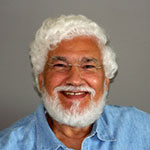February 27, 2017
Could you live without Wi-Fi?

Few of us could function "normally" for very long without Wi-Fi. Unheard of just a generation ago, this system uses a transmitter and a receiver - a transreceiver for short - to send and to receive electrical signals carrying data, voice and video signals.
The reason why Wi-Fi systems didn’t exist 50 years ago, is because it is very difficult to design a tiny microchip housing both a transmitter and a receiver in close proximity.
As a leading international specialist in microchip design, I can tell you with authority exactly how difficult it was!
My research team and I at the University of Waterloo worked hard for more than 40 years to contribute to this electronic breakthrough.
And when it was achieved, our peers gave us recognition; we received awards; we published research papers and books; my students earned doctorates; the public was grateful and of course we were granted patents.
A Wi-Fi system still feels like magic to many – especially those of us born and educated even before the first successful home computers revolutionized academia and business. Back then, we were blown away by the advent of four-function hand calculators costing under $100!
But what if I told you that truly amazing transreceivers already exist that use just a fraction of the power required by any modern Wi-Fi system?
What if I told you that this system has not just one, but billions of transceivers? What if I told you that it is a totally universal free-access system, available to every single person on this planet?
I’m sure you would agree that the designer of such a marvel should be appreciated, honored and praised the world over.
And you’d probably be incredulous if I also told you that numerous people use it daily and rarely, if ever, give a single thought to where it came from and why it works so well.
This amazing natural Wi-Fi is none other than the human nervous system, whose billions of transceivers connect every single cell in our body to a 24/7 command center, the brain.
The brain continually receives, interprets and acts upon signals that we identify as pain (warnings of malfunction), pleasure, motion, sensory stimulation (such as temperature), fatigue, etc.
Our survival is so attuned to our nervous system that if for example the signal transmission and reception between heart and brain are compromised, death can occur in mere seconds.
Or if the accuracy of the transceiver functions controlling motion and sensory input from the body are inaccurate or damaged, you could not enjoy watching a good soccer or hockey game, much less play those (or any other) sports yourself.
No wonder major athletes must train for hours every day to reach the top. Dancers, acrobats, musicians and other intensely body-dependent occupations also fall into the same category. In any of these fields, scientists tell us it takes at least 10,000 hours of continuous training to be considered a “professional.”
If we take good care of it, however, the intricate internal Wi-Fi system that makes it all possible can serve us well for some 100 years.
Many people assume that the human nervous system with these billions of transreceivers has designed, optimized and updated itself.
But there had to be a creative template, a spark of something Divine to set this scientific miracle in motion.
And the more I compare my career work in microchip design to what is going on inside my body at this very moment, the more I can appreciate the Designer that made and sustains me. Whether you call this supreme intelligence God, Jehovah, Manitou, or any other name of reverence does not matter; it is a power beyond human capability.
And please take my word:
it is impossible, now or in the future, to duplicate such a complex and self-maintaining system of billions of transreceivers in a microchip. As small and amazing as they are (and they are becoming smaller and more amazing all the time), microchips still cannot do what the human nervous system can in such small spaces, with such minuscule power requirements, and with such pinpoint accuracy.
The more you know about human “internal Wi-Fi” as it performs flawlessly at home, work, school, or while doing the things you love, the more you will appreciate its ultimate Designer.
So, the next time you experience a “dead zone” when texting or reading e-mail in the coffee shop or on the commuter train, remember that you were born with the best Wi-Fi that ever was, or ever will be. And that’s one kind of Wi-Fi you cannot live without.








